A robust website analytics strategy is essential for any business to thrive online.
WordPress, the most popular content management system,
offers a wide range of analytics tools that provide deep insights into your website’s performance.
In this comprehensive guide,
we’ll explore these tools in detail, covering everything from the basics to advanced techniques that can help you optimize your website
for better user experience and higher conversion rates.
Introduction to WordPress Analytics Tools
Analytics tools are designed to track and report on various aspects of your website’s performance.
These tools can provide critical data on visitor behavior, content performance, and overall site health for WordPress users.
Whether running a blog, an eCommerce store, or a corporate website,
understanding how users interact with your site is critical to making informed decisions.
With the right analytics tools, you can track everything from page views to conversion rates,
clearly showing what’s working and what needs improvement.
In this guide, we’ll dive deep into WordPress analytics tools,
helping you choose the best options for your site and showing you how to use them effectively.
Why WordPress Analytics Matter
Understanding why analytics are crucial is the first step toward improving your website’s performance. Here are several reasons why WordPress analytics matter:
Data-Driven Decision Making:
Analytics tools provide data that can inform your decisions.
Rather than relying on guesswork, you can base your strategies on user behavior and site performance metrics.
Optimization of Content and User Experience:
By analyzing how users interact with your site, you can identify areas where the content or design might be lacking.
For example, if a high percentage of users are bouncing off a particular page,
it may indicate that the content isn’t meeting their needs or the page isn’t user-friendly.
Conversion Rate Improvement:
Conversion tracking is one of the most critical aspects of website analytics.
By understanding how users move through your sales funnel,
you can optimize each step to improve conversion rates,
whether that means increasing sales, sign-ups, or other vital actions.
Audience Understanding:
Analytics tools can provide insights into your audience’s demographics, behavior, and preferences.
This information is invaluable for tailoring your content,
products, and marketing efforts to better meet their needs.
Performance Monitoring:
Regular monitoring of website performance metrics such as load times,
page views and user sessions can help you maintain a fast and reliable site, which is crucial for user satisfaction and SEO.
Key Features to Look for in WordPress Analytics Tools
When selecting a WordPress analytics tool, consider the features most beneficial to your specific needs.
Here are some key features to look for:
Ease of Integration:
The tool should be easy to integrate with WordPress.
Many tools offer plugins that simplify the integration process, while others may require manual code insertion.
Real-Time Data:
Real-time analytics allow you to see what’s happening on your site at any given moment.
This is particularly useful for monitoring live events, product launches, or other time-sensitive activities.
Custom Reports:
The ability to create custom reports is essential for tracking specific metrics that are important to your business.
Look for tools that allow you to tailor reports to your needs.
Event and Goal Tracking:
Event tracking enables you to monitor specific user actions, such as clicks, downloads, and form submissions.
Goal tracking allows you to set and measure key performance indicators (KPIs), helping you gauge the success of your campaigns.
User-Friendly Interface:
A tool with an intuitive and easy-to-navigate interface will save you time and make extracting the data you need easier.
Data Privacy Compliance:
With regulations like GDPR in place, choosing a tool that respects user privacy and complies with relevant laws is essential.
Some analytics tools offer features to help you manage and protect user data.
Top WordPress Analytics Tools
Numerous analytics tools are available for WordPress,
each offering different features and capabilities. Below, we’ll review some of the top options:
1. Google Analytics
Google Analytics is the gold standard in web analytics.
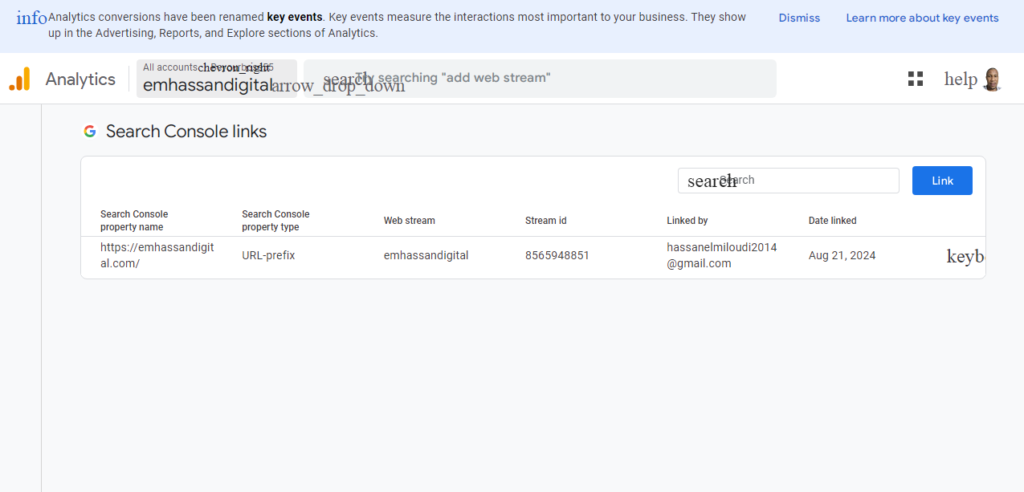
It offers a comprehensive suite of features that can track virtually every aspect of your site’s performance. With its vast array of tools and integrations,
Google Analytics suits websites of all sizes and industries.
Features:
In-depth data tracking, including page views, session duration, bounce rates, and more.
Audience segmentation is based on demographics, location, and behavior.
Goal and event tracking to measure specific user actions.
Customizable dashboards that allow you to view the most important metrics at a glance.
Integration with Google Ads, Search Console, and other Google services for a holistic view of your online presence.
Integration: Google Analytics can be integrated with WordPress through plugins like MonsterInsights or by manually adding the tracking code to your site’s header.
Pros:
Powerful and versatile, it is suitable for any website.
Extensive documentation and community support.
Free to use for most small to medium-sized websites.
Cons:
The steep learning curve, especially for beginners.
It can be overwhelming due to the sheer volume of data and features.
2. MonsterInsights

MonsterInsights is a popular WordPress plugin that simplifies the integration of Google Analytics with your site.
It’s designed to make Google Analytics more accessible to WordPress users,
offering easy-to-read reports directly within your WordPress dashboard.
Features:
Quick and easy setup, with no need to manually add tracking codes.
Customizable reports that focus on the metrics most relevant to your business.
It enhanced eCommerce tracking for online stores.
Integration with popular WordPress plugins like WooCommerce and Easy Digital Downloads.
GDPR compliance features include anonymizing IP addresses and disabling tracking for specific users.
Pros:
User-friendly interface, making it easy for beginners to get started.
Focuses on actionable insights rather than overwhelming users with data.
Offers a free version with basic features, with premium versions available for more advanced needs.
Cons:
Limited to Google Analytics data, so if you prefer another analytics platform, MonsterInsights won’t be helpful.
Some advanced features are only available in the premium version.
3. Jetpack Stats

Jetpack Stats is part of the Jetpack plugin suite, which offers a range of features for WordPress sites, including security,
performance, and marketing tools.
Jetpack Stats provides basic analytics that is easy to understand and access, making it a good option for beginners.
Features:
Real-time visitor statistics, including page views, referral sources, and search terms.
Simple, straightforward interface that presents critical metrics at a glance.
Integration with other Jetpack features, such as site security and backup services.
A mobile app that allows you to monitor your site’s performance on the go.
Pros:
Easy to set up and use, even for those with no technical background.
It is lightweight and doesn’t slow down your site.
Free to use, with no premium versions or upsells.
Cons:
Limited in scope, offering only basic analytics.
Lacks advanced features like event tracking, custom reports, and detailed audience segmentation.
4. ExactMetrics
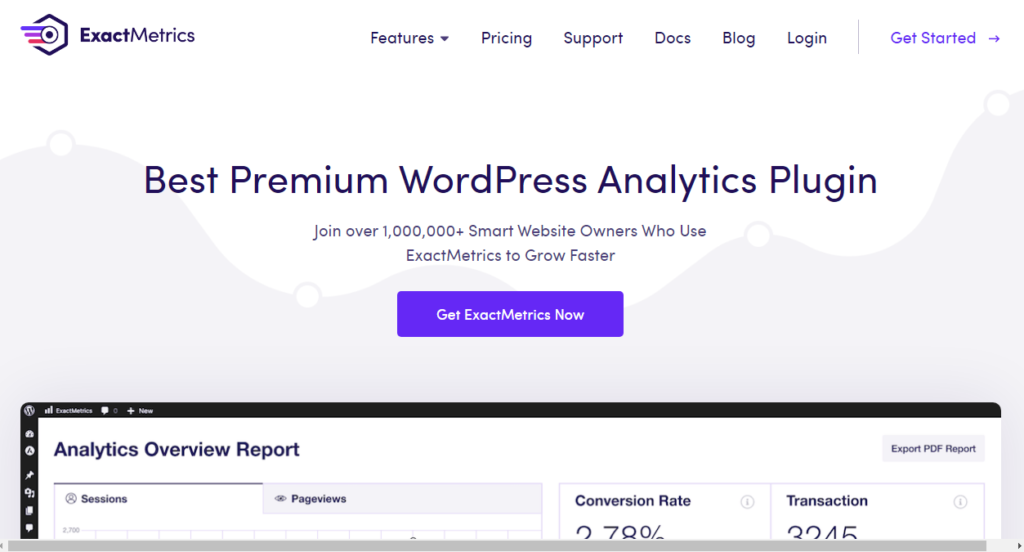
ExactMetrics is another plugin that brings Google Analytics data directly into your WordPress dashboard. It’s designed to make analytics more accessible,
with features aimed at both beginners and advanced users.
Features:
Real-time data and reports, including visitor tracking, page views, and referral sources.
Enhanced eCommerce tracking, including product performance, conversion rates, and revenue tracking.
Custom dimensions that allow you to track specific user interactions, such as logged-in users or ad clicks.
Integration with popular WordPress plugins like WooCommerce and MemberPress.
GDPR compliance tools, including IP anonymization and opt-out options.
Pros:
Easy setup with no need to manually add tracking codes.
It offers both basic and advanced features, making it suitable for a wide range of users.
Provides actionable insights that can help you optimize your site.
Cons:
It relies on Google Analytics data, so it’s unsuitable for those who prefer other analytics platforms.
Some advanced features are only available in the premium version.
5. WP Statistics
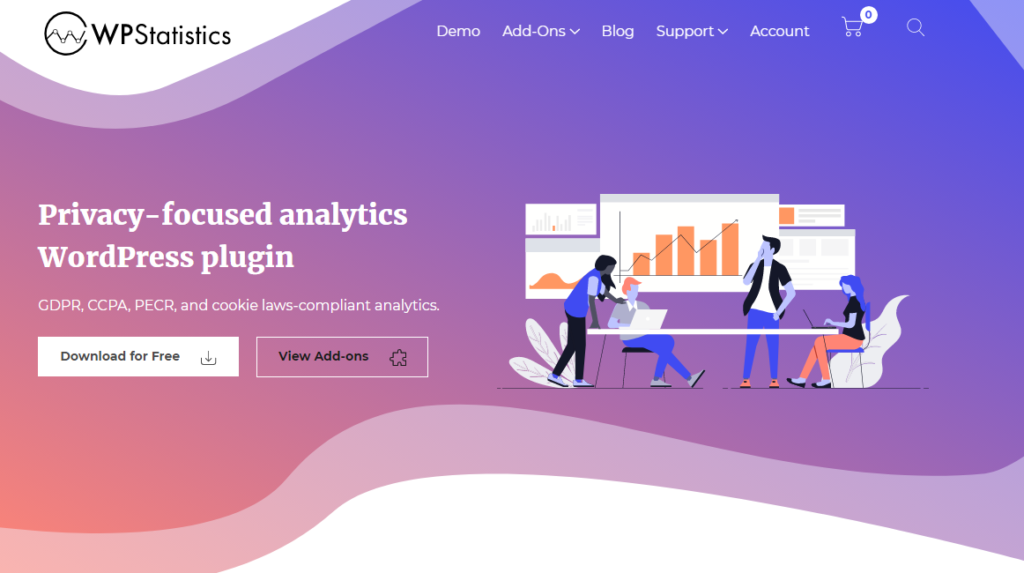
WP Statistics is a comprehensive analytics plugin that doesn’t rely on third-party services like Google Analytics.
It’s designed for users who want to keep their data private and within their servers.
Features:
Tracks various metrics, including visitor numbers, page views, and referral sources.
Provides detailed reports and visualizations, including graphs and charts.
Real-time data tracking for monitoring live traffic.
GDPR compliance tools, including data anonymization and export features.
It does not rely on external services, meaning all data is stored locally on your WordPress site.
Pros:
Ideal for users who are concerned about data privacy.
Offers a wide range of features without requiring integration with external services.
Free to use, with no premium versions or upsells.
Cons:
It can be resource-intensive, potentially slowing down your site.
Lacks the depth and sophistication of Google Analytics, particularly regarding audience segmentation and advanced tracking.
6. Matomo
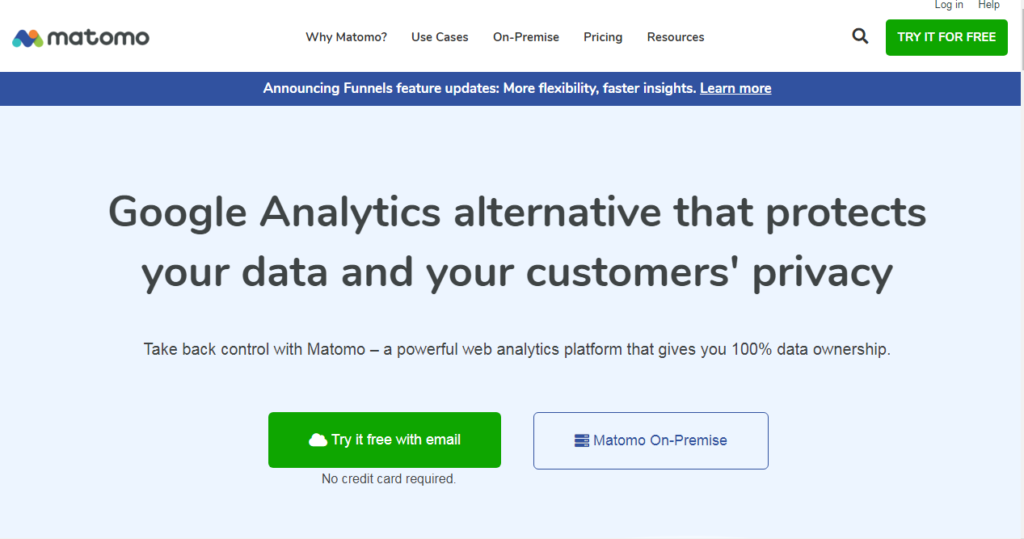
Matomo (formerly known as Piwik) is a powerful, open-source analytics platform that gives you complete control over your data.
It’s an excellent option for users who want a robust analytics tool that doesn’t rely on third-party services like Google Analytics.
Features:
Comprehensive visitor behavior tracking, including page views, downloads, and outlines.
Customizable dashboards and reports allow you to focus on the metrics most matter to you.
Built-in privacy features, including data anonymization and GDPR compliance tools.
Heatmaps and session recordings are used to visualize user behavior on your site.
A/B testing and conversion optimization tools.
Pros:
Offers a high degree of control over your data, with the option to self-host.
It includes advanced features like heat maps and A/B testing.
Open-source, with a large community of developers and users.
Cons:
Requires more technical knowledge to set up and maintain compared to other tools.
It can be resource-intensive, especially if you choose to self-host.
7. Crazy Egg
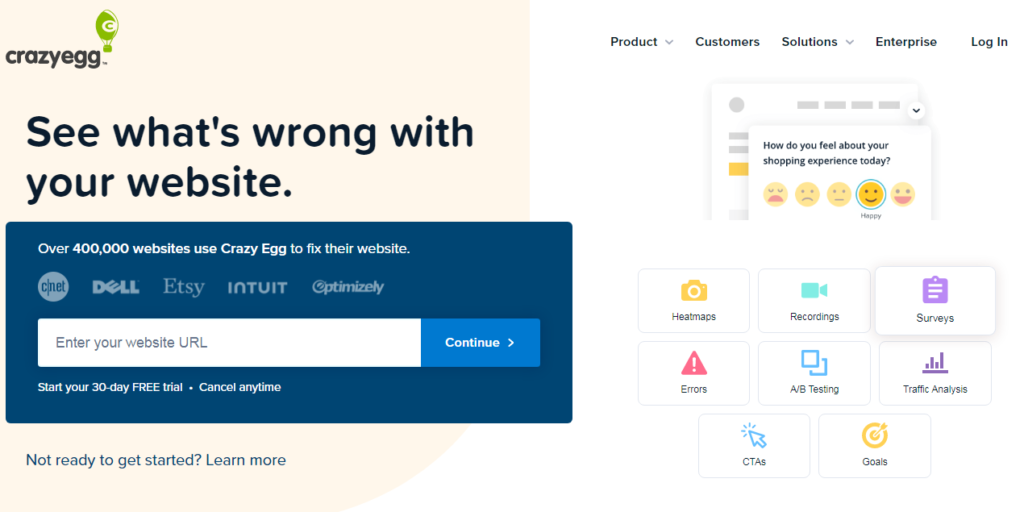
Crazy Egg is a specialized analytics tool that visualizes user behavior through heatmaps and scroll maps. It’s beneficial for optimizing landing pages and improving user experience.
Features:
Heatmaps that show where users click and scroll on your pages.
Scrollmaps that reveal how far down the page users are scrolling.
A/B testing tools are used to compare different versions of your pages.
User session recordings that let you watch how visitors interact with your site.
Integration with WordPress through a plugin or by adding a tracking code.
Pros:
Provides unique insights into user behavior that traditional analytics tools can’t offer.
Easy to set up and use, with a focus on visual data.
Great for optimizing landing pages and improving conversion rates.
Cons:
It is limited in scope, focusing primarily on visualizing user behavior rather than providing comprehensive analytics.
Paid tool, with pricing based on the number of page views tracked.
8. Heap Analytics

Heap Analytics is a modern analytics platform that automates tracking user interactions. It allows for a complete picture of user behavior without manually setting up events.
Features:
Automatic event tracking captures your site’s click, tap, and form submission.
It has advanced segmentation and analysis tools that allow you to drill down into user behavior.
Funnels and conversion rate optimization tools for improving your site’s performance.
Integration with WordPress through custom scripts or third-party plugins.
GDPR compliance tools, including data anonymization and opt-out features.
Pros:
Automates much of the tracking process, saving you time and effort.
Provides a comprehensive view of user behavior without requiring manual event setup.
Powerful segmentation and analysis tools.
Cons:
Paid tool, with pricing based on the number of tracked sessions.
It may require some technical knowledge to set up and integrate with WordPress.
How to Integrate Analytics Tools with WordPress
Integrating analytics tools with WordPress can range from simple plugin installations to more complex setups involving custom scripts.
Here’s a general guide to incorporating some of the most popular tools:
Google Analytics:
Plugin Method: Install and activate the MonsterInsights or ExactMetrics plugin. Follow the setup wizard to connect your Google Analytics account to your WordPress site.
Manual Method: Create a Google Analytics account and obtain your tracking ID. Add the tracking ID to your site’s header.php file or use a custom plugin like Insert Headers and Footers to add the code.
Jetpack Stats:
Install and activate the Jetpack plugin. Connect it to your WordPress.com account.
Enable the “Site Stats” module in Jetpack’s settings to track basic analytics.
WP Statistics:
Install and activate the WP Statistics plugin from the WordPress plugin repository.
Configure the settings to suit your needs, including enabling features like real-time tracking and GDPR compliance.
Matomo:
Self-Hosted Method: Download the Matomo software and install it on your server. Follow the setup instructions to configure Matomo and integrate it with your WordPress site.
Cloud-Hosted Method: Sign up for Matomo’s cloud-hosted service. Obtain your tracking code and add it to your WordPress site using a plugin like Insert Headers and Footers.
Crazy Egg:
Sign up for a Crazy Egg account and obtain your tracking code.
You can add the tracking code to your WordPress site using a custom plugin or editing your theme’s header.php file.
Heap Analytics:
Sign up for a Heap Analytics account and obtain your tracking code.
You can add the tracking code to your WordPress site using a custom plugin or editing your theme’s header.php file.
Advanced Analytics Techniques
Once you’ve integrated your analytics tools, you can start using advanced techniques to gain deeper insights into user behavior and optimize your site:
Event Tracking
Event tracking allows you to monitor specific user interactions, such as clicks on buttons, video plays, or form submissions.
This data is crucial for understanding how users engage with your content and can help you identify areas for improvement.
Google Analytics:
Use the Google Analytics interface or plugins like MonsterInsights to set up event tracking.
Define the events you want to track (e.g., “button click”) and specify the conditions under which the event is triggered.
Heap Analytics:
Automatically tracks events without requiring manual setup. Use the Heap interface to view and analyze event data.
Conversion Tracking
Conversion tracking helps you measure the effectiveness of your marketing campaigns.
Track actions contributing to your business goals, such as purchases, sign-ups, or form submissions.
Google Analytics:
Set up goals in Google Analytics to track conversions. Define your goals (e.g., “form submission”) and specify the conversion path.
Matomo: Use Matomo’s goal-tracking features to define and measure conversions on your site.
A/B Testing
A/B testing, or split testing, involves comparing two versions of a page or element to see which performs better.
Analytics tools can help you track the performance of each variant, leading to data-driven optimization.
Google Optimize: Use Google Optimize, integrated with Google Analytics, to create and run A/B tests on your site.
Crazy Egg: Use Crazy Egg’s A/B testing tools to compare different versions of your landing pages and identify the most effective design.
Heatmaps
Heatmaps visually represent user behavior, showing where users click, scroll, and spend the most time on your pages.
This data is invaluable for optimizing user experience and improving conversion rates.
Crazy Egg: Offers detailed heatmaps and scrollmaps showing where users engage with your content.
Matomo: Includes heatmap and session recording features that allow you to visualize user interactions.
User Flow Analysis
User flow analysis tracks users’ paths through your site, from entry to exit. Understanding these paths can help optimize your site’s navigation and improve user retention.
Google Analytics: Use the Behavior Flow and User Flow reports in Google Analytics to visualize how users navigate your site.
Heap Analytics: Automatically tracks user flows and provides detailed reports on how users move through your site.
Standard Analytics Mistakes to Avoid
Mistakes can skew data or lead to incorrect conclusions even with the best tools and techniques.
Here are some common analytics mistakes to avoid:
Not Setting Up Goals:
Success is impossible to measure without clearly defined goals. Set goals in your analytics tool to track conversions and other vital actions.
Ignoring Mobile Analytics:
With mobile traffic accounting for a significant portion of web visits, monitoring mobile-specific metrics is crucial.
Ensure that your analytics tool tracks mobile user behavior and includes mobile-specific reports.
Overlooking Data Privacy:
Failing to comply with data privacy regulations like GDPR can lead to legal issues and damage your reputation.
Ensure your analytics tools are set up to respect user privacy and comply with relevant laws.
Relying Solely on Vanity Metrics:
Metrics like page views and session duration are essential but don’t tell the whole story.
Focus on actionable metrics that align with your business goals, such as conversion rates and user engagement.
Not Regularly Reviewing and Updating Your Analytics Setup:
As your site evolves, so should your analytics setup.
Regularly review your tracking and reporting settings to ensure they align with your current business objectives.
Future Trends in WordPress Analytics
The world of web analytics is constantly evolving, and staying ahead of the curve can give you a competitive edge.
Here are some trends to watch in the coming years:
Artificial Intelligence and Machine Learning:
AI and machine learning increasingly integrate into analytics tools, offering more accurate predictions and automated insights.
Expect more AI-powered features in analytics platforms, which will help you make data-driven decisions faster and more precisely.
Enhanced Privacy Controls:
With growing concerns around data privacy,
Analytics tools will likely offer more robust privacy features, including advanced data anonymization and user consent management.
This will be essential for maintaining compliance with evolving privacy regulations.
Increased Focus on User Experience:
As user experience becomes a key differentiator for websites, analytics tools will continue to develop features that provide deeper insights into user behavior and satisfaction.
Expect more sophisticated tools for tracking and analyzing UX-related metrics.
Real-Time Personalization:
Thanks to advances in analytics and automation,
the ability to deliver personalized content and experiences in real time is becoming a reality.
Look for tools that offer real-time personalization features.
These features allow you to tailor your site to individual visitors based on their behavior and preferences.
Integration with IoT and Voice Search:
As the Internet of Things (IoT) and voice search become more prevalent,
analytics tools must adapt to track and analyze interactions across these new channels.
This will open up new opportunities for understanding and optimizing user engagement.
Conclusion
WordPress analytics tools are indispensable for optimizing their website and achieving business success. From basic visitor tracking to advanced techniques like A/B testing and heatmaps,
these tools provide the data and insights you need to make informed decisions, improve user experience, and boost conversion rates.
Whether you’re just starting with analytics or looking to improve your tracking, there’s a tool for you.
The key is to choose the right tools, set them up correctly, and use the data they provide to drive continuous improvement on your site.
Remember, analytics is not a one-time task but an ongoing process.
To ensure your WordPress site performs at its best, regularly review your data, experiment with new strategies, and stay updated on the latest trends.
With the right approach to analytics, your website can become a powerful tool for achieving your business goals and staying ahead of the competition.





2 Responses
Usually I do not read article on blogs however I would like to say that this writeup very compelled me to take a look at and do it Your writing style has been amazed me Thank you very nice article
you are welcome